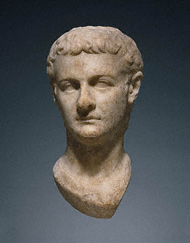 |
 |
 |
 |
Grades/Level: High School (9–12)
Subjects: Visual Arts, History–Social Science
Time Required: 2–Part Lesson
2-3 class periods, plus independent research
Author: J. Paul Getty Museum Education Staff
Permissions: 
The lesson plan and downloadable materials on this page are licensed under a Creative Commons Attribution 4.0 International License. |
 |
|
 |
 |
 |
 |
 |
 |
 |
Lesson Overview |
 |
Students will compare propagandistic strategies in artworks to modern-day examples of persuasive techniques and create a propaganda poster for a current political leader. |
 |
 |
 |
 |
 |
Learning Objectives |
 |
Students will be able to:
• compare and contrast the techniques used to establish a leader's right to rule in an ancient portrait and a 17th-century cabinet;
• compare uses of propaganda in antiquity, the 17th century, and the present;
• research examples of various ways the U.S. government has promoted its political agenda;
• create a propaganda poster for a current political leader using persuasive techniques found in artworks and modern-day media. |
 |
 |
 |
 |
 |
 |
 |
 |
 |
Materials |
 |
• Reproduction of Cabinet on Stand by André-Charles Boulle
• Reproduction of Head of Emperor Caligula by an unknown Roman artist
• Background Information and Questions for Teaching about the cabinet and bust (click on the thumbnails of the works below)
• Video: The Merchants of Cool (a VHS or DVD copy can be ordered or a streaming video can be viewed on the PBS Web site Frontline)
• VHS or DVD player (optional)
• Student Handout: Powers of Persuasion |
 |
 |
 |
 |
 |
|
|
 |
 |
 |
 |
 |
Lesson Steps |
 |
Download the complete lesson by clicking on the "download this lesson" icon above.
Additional Resource:
Learn more about Cabinet on Stand by André-Charles Boulle and zoom in on its elaborate details.
Watch a video about the process of making marquetry, a technique used to create the decorations on Cabinet on Stand.
Glossary Terms:
Words in bold on these pages and in the lesson are defined in the glossary for this curriculum (see "For the Classroom" links above).
|
 |
 |
 |
| Head of Emperor Caligula, Roman, about A.D. 40 |
 |
|
 |
 |
 |
 |
 |
 |
 |
Standards Addressed |
 |
Common Core Standards for English Language Arts
Grades 9–12
READING
Integration of Knowledge and Ideas
7. Integrate and evaluate content presented in diverse media and formats, including visually and quantitatively, as well as in words.
WRITING
Research to Build and Present Knowledge
7. Conduct short as well as more sustained research projects based on focused questions, demonstrating understanding of the subject under investigation.
8. Gather relevant information from multiple print and digital sources, assess the credibility and accuracy of each source, and integrate the information while avoiding plagiarism.
9. Draw evidence from literary or informational texts to support analysis, reflection, and research.
SPEAKING AND LISTENING
Comprehension and Collaboration
1. Prepare for and participate effectively in a range of conversations and collaborations with diverse partners, building on others' ideas and expressing their own clearly and persuasively.
2. Integrate and evaluate information presented in diverse media and formats, including visually, quantitatively, and orally.
For more national and California state standards for this curriculum, refer to the charts found in the links at the top right of this page.
|
 |

|
 |
 |
 |




